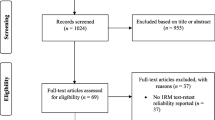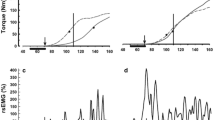Abstract
Study Design: A control group study with repeated measures. Objective: To compare trunk repositioning parameters in chronic low back pain (LBP) and healthy subjects. Summary and background data: Recent evidence suggests that chronic LBP patients exhibit deficits in trunk proprioception and motor control. Trunk repositioning and the various spatio-temporal parameters related to it can be used to evaluate sensori-motor control and movement strategies. Methods: Fifteen control subjects and 16 chronic LBP subjects participated in this study. Subjects were required to reproduce different trunk position in flexion (15°, 30° and 60°) and extension (15°). In the learning phase preceding each condition, visual feedback was provided. Following these learning trials, subjects were asked to perform ten consecutive trials without any feedback. Movement time, movement time variability and peak velocity were obtained and a temporal symmetry ratio was calculated. Peak angular position variability and absolute error in peak angular position were also calculated to evaluate spatial accuracy. Results: Two subgroups of LBP patients were identified. One subgroup of LBP subjects demonstrated longer movement time and smaller peak velocities and symmetry ratios than normal subjects. No group difference was observed for peak angular position variability and absolute error in peak angular position. Conclusion: Chronic LBP patients, when given a sufficient learning period, were able to reproduce trunk position with a spatial accuracy similar to control subjects. Some LBP subjects, however, showed modifications of movement time, peak velocity and acceleration parameters. We propose that the presence of persistent chronic pain could induce an alteration or an adaptation in the motor responses of chronic LBP subjects.


Similar content being viewed by others
References
Al-Obaidi SM, Nelson RM, Al-Awadhi S, et al (2000) The role of anticipation and fear of pain in the persistence of avoidance behavior in patients with chronic LBP. Spine 25:1126–1131
Brumagne S, Cordo P, Lysens R, et al (2000) The role of paraspinal muscle spindles in lumbosacral position sense in individuals with and without LBP. Spine 25:989–994
Brumagne S, Lysens R, Swinnen S, et al (1999) Effect of paraspinal muscle vibration on position sense of the lumbosacral spine. Spine 24:1328–1331
Cholewicki J, McGill SM (1996) Mechanical stability of the in vivo lumbar spine: implications for injury and chronic LBP. Clin Biomech (Bristol, Avon) 11:1–15
Descarreaux M, Blouin JS, Teasdale N (2004) Force production parameters in patients with LBP and healthy control study participants. Spine 29:311–317
Frymoyer JW, Ducker TB (1997) The adult spine: principles and practice, 2nd edn. Lippincott-Raven, Philadelphia
Gill KP, Callaghan MJ (1998) The measurement of lumbar proprioception in individuals with and without LBP. Spine 23:371–377
Holm S, Indahl A, Solomonow M (2002) Sensorimotor control of the spine. J Electromyogr Kinesiol 12:219–234
Indahl A, Kaigle A, Reikeras O, et al (1995) Electromyographic response of the porcine multifidus musculature after nerve stimulation. Spine 20:2652–2658
Indahl A, Kaigle AM, Reikeras O, et al (1997) Interaction between the porcine lumbar intervertebral disc, zygapophysial joints, and paraspinal muscles. Spine 22:2834–2840
Jaric S, Corcos DM, Latash ML (1992) Effects of practice on final position reproduction. Exp Brain Res 91:129–134
Jaric S, Gottlieb GL, Latash ML, et al (1998) Changes in the symmetry of rapid movements. Effects of velocity and viscosity. Exp Brain Res 120:52–60
Newcomer K, Laskowski ER, Yu B, et al (2000) Repositioning error in LBP. Comparing trunk repositioning error in subjects with chronic LBP and control subjects. Spine 25:245–250
Newcomer KL, Laskowski ER, Yu B, et al (2000) Differences in repositioning error among patients with LBP compared with control subjects. Spine 25:2488–2493
Newell KM (1976) Knowledge of results and motor learning. Exerc Sport Sci Rev 4:195–228
Newell KM, Walter CB (1981) Kinematic and kinetic parameters as information feedback in motor skill acquisition. J Human Movements Stud 7:235–254
O’Sullivan PB, Burnett A, Floyd AN, et al (2003) Lumbar repositioning deficit in a specific LBP population. Spine 28:1074–1079
Parkhurst TM, Burnett CN (1994) Injury and proprioception in the lower back. J Orthop Sports Phys Ther 19:282–295
Radebold A, Cholewicki J, Polzhofer GK, et al (2001) Impaired postural control of the lumbar spine is associated with delayed muscle response times in patients with chronic idiopathic LBP. Spine 26:724–730
Schmidt RA, Lee TD (1999) Motor control and learning: a behavioral emphasis, 3rd end. Human Kinetics, Champaign, Ill., USA
Sherwood DE (1988) Effect of bandwidth knowledge of results on movement consistency. Percept Mot Skills 66:535–542
Waddell G (1987) Volvo award in clinical sciences. A new clinical model for the treatment of low-back pain. Spine 12:632–644
Acknowledgements
The authors thank Marcel Kaszap for technical support. This study was supported by FCQ, CIHR-FCQ, NSERC-Canada and FCAR-Québec.
Author information
Authors and Affiliations
Corresponding author
Rights and permissions
About this article
Cite this article
Descarreaux, M., Blouin, JS. & Teasdale, N. Repositioning accuracy and movement parameters in low back pain subjects and healthy control subjects. Eur Spine J 14, 185–191 (2005). https://doi.org/10.1007/s00586-004-0833-y
Received:
Accepted:
Published:
Issue Date:
DOI: https://doi.org/10.1007/s00586-004-0833-y




